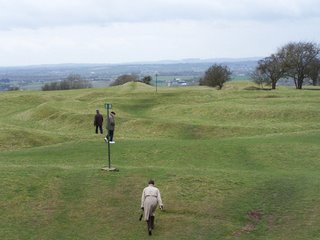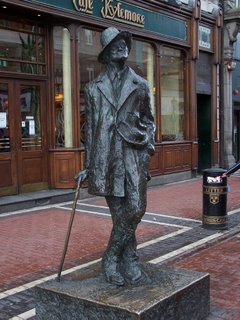By far the best way to hear an abbreviated body of lore and legends in this town is on board a hop-on hop-off bus, that will also take you to 20 'must see' spots, on a ticket that's good for 24 hours. Every driver has different tales to tell at different parts of the city - there's no standard patter - sometimes even the routes change!
What I'm seeing is a nation of singers and storytellers - so it's no surprise to learn that in Ireland's Golden Age (5th-9th centuries, called the Dark Ages everywhere else in Europe), they were known as the 'land of priests and scholars'. Irish monks founded monasteries all over Europe, notably in Switzerland Austria and Germany, taking with them gorgeously illustrated books and manuscripts (more about those another day). This was the age of 142 High Kings crowned at Tara, overlooking 22 of the nations 31 counties, when craftsmen wrought gorgeous pins and elaborate jewelled brooches, and Irish traders brought diverse luxuries home in return for gold. Here too, the Irish were converted to Catholicism by St Patrick in the 5th Century - those tricksy monks offered the secret of writing in Latin in return for the immortal souls of kings, who apparently figured the deal quite a bargain!
 Hill of Tara, above, and St Patrick's Statue behind the church on one side of the hill
Hill of Tara, above, and St Patrick's Statue behind the church on one side of the hill
Small wonder the Vikings came to play. A stone called the Stein, (which has taken various forms through the ages - current incarnation shown below) has marked since the 8th Century the original Viking landing point and site of docks on the banks of the Liffey. It's now 150 metres inland, as swampy bank has been reclaimed over the last 250 years...
 The next wave of invaders was, of course, the English, and I defy anyone to come to this country and NOT side emphatically with the locals. (In pubs, I've taken to calling myself 'of Welsh descent', which is true, I' m 25%, and only fessing up to the rest being English blood after being welcomed as a fellow Celt. Apparently, as long as I'm Aussie, and not fullblooded pom, it's okay...).
The next wave of invaders was, of course, the English, and I defy anyone to come to this country and NOT side emphatically with the locals. (In pubs, I've taken to calling myself 'of Welsh descent', which is true, I' m 25%, and only fessing up to the rest being English blood after being welcomed as a fellow Celt. Apparently, as long as I'm Aussie, and not fullblooded pom, it's okay...).The irony, however, is that the first English (Norman) warriors were invited here, to help the king of Leinster sort out some border skirmishes. Enter one Richard de Clare, called Strongbow, the Earl of Pembroke, who landed in 1170. It took nearly 800 years for the poms to figure that they weren't welcome, and leave... Strongbow married Aoife (Eve), princess of Leinster (and you can read about him here, and his famous son in law, William Marshall, here).
The troubles experienced by the Irish at the hands of the English are legion - but to understand them, you really have to visit this place, so I won't go into them here. To the credit of the Irish, they don't dwell on the long list of injustices perpetrated over centuries. They do, however, sing unceasingly the praises of their patriots, the men and women who achieved significant gains in the fight for Irish voting and land rights. Daniel O'Connell (after whom my 'local' in Melbourne is named, and pictured below) for securing the vote for persons without land, Wolf Tone, Charles Parnell, Michael Collins, the unionist Jim Connolly, and of course, the men and women of the Easter Rising of 1916, 14 of whom were shot, including the legendary Robert Pearse. Others, including Constance Markiewicz and Eamon de Valera (who became the first prime minister and President after a lucky let-off because he was entitled to US citizenship, and the Poms needed the US in the war) escaped with prison terms instead.
This recent history is everywhere - from the Post Office (first pic below), which still bears bullet holes from the 1916 rising, to Kilmainham Gaol - the most chilling, moving and strangely inspiratioal place I've seen on these travels - to the legion of statues dotted around the city. The 'new wing' has featured as a setting in film clips by U2 and the film 'In the Name of the Father' - the image below that is of the 'old' cells, where the condemned from the Easter rising were held.
 Above - Dublin Post office, below, Kilmainham Gaol
Above - Dublin Post office, below, Kilmainham Gaol

Statues also commemorate the famed writers in this nation of scribes and scholars - James Joyce (pictured, below, with his shoes on the wrong feet - oops!), Oscar Wilde, Bram Stoker (who married a woman who had previously been engaged to Wilde), George Bernard Shaw, Yeats and a host of others. Musicians, too, have a special place here - one bus driver shows us the very corner where fellas called Bono and The Edge started busking back in the day, another cheerily tells of all Dublin turning out to watch U2 receive the keys to the city - the following day, Bono, exploiting an old and never-repealed law, exercised his right as a Freeman of the City to graze livestock on St Stephens Green (a carefully tended park akin to the Fitzroy Gardens at home)... and herded in a small flock of sheep.

So much walking and writing, learning and talking, is enough to work up a thirst in anyone. What of the cider? I'm glad you asked. The house cider, almost everywhere you turn, is Bulmers, and it tastes a little sweeter and spicier than it does in Australia. Naturally, you'll all understand now why nothing called Strongbow would ever get served in this part of the world...



No comments:
Post a Comment